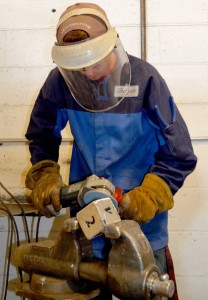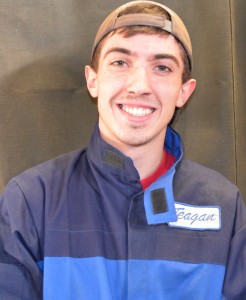IDAHO FALLS — In Idaho’s professional-technical high schools, providing access to post-secondary educational opportunities is more than a suggestion — it’s a mandate.
The state requires professional-technical high schools provide advanced learning opportunities for students to speed up the process of earning a technical certificate or associate’s degree.
But determining the best way to provide college credit opportunities and transition high schoolers into college is still a big question for many PTE educators across Idaho.
“It’s a frustration across the state,” Principal Craig Miller said. “The biggest problem with (advanced opportunities) is there is no statewide agreement for (credit transfer).”

Miller is head of the Technical Careers High School in Bonneville Joint School District 93. One of his responsibilities is cultivating articulation agreements, which allow for credit transfer between his school’s programs and programs at individual post-secondary institutions.
These agreements work with varying degrees of success.
“We’re dealing with individual colleges,” Miller said. “At one you might have a great relationship and they will accept tech prep and dual credit, but other programs may not be willing to do the same.”
The welding program at the Technical Careers High School maintains an excellent relationship with Eastern Idaho Technical College. Their articulation agreement ensures a large portion of secondary welding credits can be turned into college credit.
Teagan Holm, 17, is one of the welding students planning to take advantage of the robust agreement to get a head start in college.
“The fact that I can go to EITC is a big bonus … this program will help me more easily catch on in college, because it’s teaching me what I need to know now,” he said. “It will also get me six of the 68 credits toward my associate degree in welding.”
But Holm’s high school credits may not go as far if he decides to apply to a different school with a separate articulation agreement.
“If you look at a catalog at ISU, EITC or (College of Southern Idaho), they all have different courses and that is a problem for student articulation,” said Susan Johnson, Idaho PTE Program Standards Director. “A student in eastern Idaho may articulate to EITC, but if they try to take that to ISU or CSI, the course doesn’t exist because the competencies are different.”
PTE students may spend high school working to earn college credit only to find those credits won’t be accepted at the college of their choosing.
A lot of the decision making that goes into accepting or declining credit depends on the methods used by professional-technical high schools to award post-secondary credit.
Professional-technical opportunities or tech prep
The most common form of earned college credit in PTE is through professional-technical advanced opportunities — more commonly known as Tech Prep programs.

Tech Prep is a competency based system where post-secondary educators evaluate a student’s high school transcript and pick out the technical skills, which match those taught at the college. A student may take numerous high school courses to earn the competency required to receive credit for a single college course.
A benefit of the Tech Prep system is reduced academic risk for students. A student has three years to decide if they want to apply high school credit to college. Tech prep courses also reduce college tuition and have been shown to improve college go-on rates.
The downside is Tech Prep programs don’t generally allow educators enough time to teach students all the competencies required by colleges to earn complete certificates or degrees while in high school.
“There has to be a sufficient amount of time built into (student’s) schedules to satisfy degree requirements,” EITC President Steve Albiston said. “I think it would take students attending school outside the normal time period to make it happen.”
Dual enrollment credits
The other option for earning college credit is through dual enrollment credits.
A dual enrollment course is a full-fledged college course taught at a high school through an agreement with a college or university. These high school credits transfers directly into college credit and courses appear on college transcripts.
The advantage of dual credit is it takes less time and fewer courses for students to earn college credits in high school. As a result, students can earn significantly more credit on average. Classes also are significantly cheaper than their collegiate equivalents.
But there is more risk involved. If a PTE student fails a dual credit course that grade will appear on a college transcript, which may adversely impact their ability to enroll in college.
Dual credit courses also count toward financial aid eligibility. Federal Pell grants are only available to students with 150 percent of credits required for a bachelor’s degree. Students who take too many dual credits in high school may find themselves ineligible for financial aid by the end of college.
“If we aren’t educating our students about the long-term implications of dual credits, we could be setting students up for a really bad deal,” Miller said.
Working toward a better system
Regardless of the method PTE schools use to provide advanced learning opportunities, there remains an underlying issue. The success of credit transfers is still highly variable on agreements with post-secondary institutions.
But efforts are underway to remedy that problem. Idaho PTE is working to develop a standardized system for transitioning professional-technical credits.
“We’ve been trying to identify standards that should be the core fundamental standards of every PTE program regardless of where it is taught in secondary or post-secondary institutions,” Johnson said.
Idaho PTE has started the process with welding since it is the most recognizable professional-technical program. The division is holding meetings with state institutions to determine the core standards required for the PTE program.
They are also working with industry to ensure the competencies taught in school match up with those required in the work force.
The biggest roadblock thus far is getting everyone on the same page, Johnson said.
“Getting the work done on all our programs and getting everyone together takes a lot of time and money,” she said. “Locally we are seeing efforts underway (between schools) to get past these roadblocks, but this also needs to happen at the state level.”
In eastern Idaho, discussions between EITC and the Technical Careers High School to improve credit transfer continue. Both institutions are interested in offering full-fledged certificates at the high school level, but there are still logistical issues to overcome.
“We are in continued dialogue with PTE high schools,” Albiston said.”If we can get to the point of offering four or five dual enrollment classes we can take little (steps) toward a completed certificate. I don’t know if we’ll ever reach that point, but I hope that we will.”
